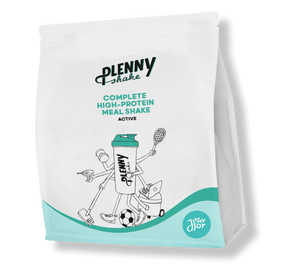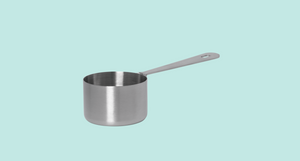
At Jimmy Joy we choose the ingredients for your meals with great care. Our science-based approach makes sure you only get the best: great nutrition, great taste, and sustainability too!
In this article we’ll take a look at all the ingredients that go into Plenny meals and why.
Let’s take a look at:
- Oats
- Soy
- Rice
- Vitamin and mineral mix
- Aromas
- Black beans
- Cocoa powder
- Cellulose gum
- Coconut
- Fruit
- Glucose syrup
- Glycerin
- Green lentils
- Golden flaxseed
- Guar gum
- Inulin/chicory root fibre
- Maltodextrin
- Microcrystalline cellulose
- Pea protein isolate
- Potato starch
- Probiotic: Bacillus coagulans
- Rapeseed oil
- Rice syrup
- Seasoning
- High-linoleic Sunflower oil
- Sweetener: sucralose
- Tapioca starch
- Vegetables
- White rice
- Wholemeal pasta
- Buckwheat
- Freeze-dried microalgae: Tetraselmis chuii
- Almonds

Oats
Oats are a main ingredient in our Plenny Shakes and Plenny Bars are low-glycemic. This means that blood sugar levels stay constant after consumption. This beneficial effect is mainly thanks to the insoluble fibres, called beta-glucans, which are naturally present in oats. By the way, those beta-glucans also help to slow down digestion and help lower blood pressure and cholesterol. [33-37]
Occurs in: Plenny Shake (oat flour), Plenny Shake Active (oat flour), Plenny Drink (oat extract, oat fibre), Plenny Bar (oat flour)
Soy
We add soy flour and soy protein isolate, which add protein and fats to our Plenny meals. Soy flour contains mostly polyunsaturated fats and adds to the omega-6 contents. The protein in soy has a high digestibility and absorption rate, which is why we use soy protein isolate.
Did you know that soy has a PDCAAS of 1? This means that soy protein provides 100% of the essential amino acids! Soy is the only plant-based protein source that scores this well. On top of that, soy protein isolate has a smooth texture and taste, and contributes to a great flavour profile.
We add Soy lecithin as a natural emulsifier, which enables the ingredients to remain well mixed in the Plenny Drink.
You can read more about soy in this article. [57-59]
Occurs in: Plenny Shake (soy flour, soy protein isolate), Plenny Shake Active (soy flour, soy protein isolate), Plenny Drink (soy protein isolate, soy lecithin), Plenny Pot (soy protein isolate), Plenny Bar (soy protein isolate)

Rice flour
Rice flour and rice extract makes sure there are healthy, complex carbs in your meals, without any free sugars! These offer a rapid energy boost without causing a spike in blood glucose levels, thanks to our complex formulations designed to keep slow digestion. As a result, they contribute to maintaining more stable blood sugar levels after consumption. [53]
Occurs in: Plenny Shake (rice flour), Plenny Bar (dehydrated rice extract).

Vitamin and mineral mix
It’s important for nutritionally complete meals to have the right micronutrient amounts. This is why we add all 26 essential vitamins and minerals in a customised mix. This mix makes sure you consume at least 20% of the reference intake per portion. You can read more about the micronutrients and the specific forms we add.
Occurs in: all meals.

Aromas
Aromas, also known as flavourings, are added to our meals to give them a nice taste and smell. EFSA (the European Food Safety Authority) carefully checks and reviews each aroma before it becomes available on the market - that’s why safety is guaranteed. Aromas are only added in very small amounts. Tasty and harmless! All aromas we use are natural, except for the vanilla flavouring in the Plenny Shake and Plenny Shake Active [1].
Occurs in: Plenny Shake, Plenny Shake Active, Plenny Pot, Plenny Drink, Plenny Bar

Black beans
Black beans are in the Plenny Pot Creamy Cajun Pasta, where they work their magic by adding to the protein and fibre content. [2]
Occurs in: Plenny Pot
 Cocoa powder
Cocoa powder
Cocoa powder is a natural source of tastiness, and we use it in all our chocolate-flavoured meals. It adds a bit of saturated fatty acids while remaining well within a healthy range. On top of that, cocoa contains high concentrations of health-promoting polyphenols, which are presumed to have anti-inflammatory effects. [3,4]
Occurs in: Plenny Shake, Plenny Shake Active, Plenny Drink, Plenny Bar

Cellulose gum
This fibre makes the Plenny Drink creamier, which is awesome because otherwise, we would have to use fats to do that! The fact that it makes the consistency thicker has some interesting health benefits: it slows down the eating rate and gastric emptying, which allows for all nutrients to be absorbed, ánd it makes you feel more fulfilled throughout the day. [7,8]
Occurs in: Plenny Drink

Coconut
Coconut milk powder and coconut oil powder contribute to the overall fat content of the Plenny Pot. Because of their saturated fatty acid content, coconut fats are not always greeted with much enthusiasm. But coconut-derived fats consist of medium-chain triglycerides (MCT), which, current research suggests, have a positive effect on weight loss, fat loss, energy-burning and improving your gut health. Just to be on the safe side, the saturated fatty acid content of the Plenny Pot is still well below the recommended upper limit of 10E%! [11-16]
Occurs in: Plenny Pot, Plenny Shake Coconut (coconut milk powder)
 Fruit
Fruit
Our fruity-flavoured meals are flavoured and coloured with real fruit! We use freeze-dried fruit. Freeze-drying is a dehydration method that yields high-quality products: the loss of flavour and aroma is minimised, while the preservation of nutrients such as vitamins is maximised! [17]
Occurs in: Plenny Shake (except in the Plenny Shake Passionfruit), Plenny Shake Active, Plenny Bars.
Glucose syrup
Glucose syrup is added to the Plenny Pots for a boost of instant energy. Yet, the complex composition of this product prevents a sugar peak or dip! [18]
Occurs in: Plenny Pot

Glycerin
Glycerine is used as a humectant in the Plenny Bars: it extends the shelf life by reducing water activity. It also retains moisture, adds volume, and improves the softness of the meal. [19]
Occurs in: Plenny Bar

Green lentils
Green lentils are in the Plenny Pot Tikka Masala, where they contribute to the protein and fibre content. Besides that, it gives a nice bite! [2]
Occurs in: Plenny Pot

Golden flaxseed
Did you know that flaxseed is one of the richest natural sources of alpha-linolenic acid (ALA)? Its high content of α-Linolenic acid (omega-3) and linoleic acid (omega-6) is especially important for the fatty acid profile of our meals. And compared to consuming the whole seed, the bioavailability of ALA is higher in milled flaxseed!
The milled flaxseed also contributes to the protein and fibre content in our meals.
Recently, concerns have arisen about the presence of high levels of hydrocyanic acid in flaxseed, especially cyanide. For this reason, the European Food Safety Authority (EFSA) has strict regulations about the presence of these compounds. Flaxseed contains very small amounts of cyanide, and the flaxseed we use undergoes heat treatment. This ensures the amounts fall well below the European Food Safety Authority advisory safe limit! [20-25]
Occurs in: Plenny Shake, Plenny Shake Active, Plenny Pot (ground flaxseed and flaxseed oil), Plenny Bar

Guar gum
Like cellulose gum, the consistency of the Plenny Drink is thickened by guar gum. But better yet: a moderate intake of this fibre is associated with cholesterol- and glucose-lowering effect and helps with weight loss thanks to its gel-forming properties. Guar gum also contributes to increased satiation, since it slows down the rate of eating and gastric emptying. [26,27]
Occurs in: Plenny Drink

Inulin/chicory root fibre
Inulin, derived from chicory roots, is a source of fibre in our meals. It has a low caloric value because it is not digested. Instead, inulin goes to the colon and acts as a prebiotic: a source of nutrition for the microbiota in the gut. This is pretty cool because good bacteria help you stay healthy by leaving less room for bad bacteria to grow! Also, inulin promotes the absorption of calcium, magnesium and iron. [28-30]
Occurs in: Plenny Shake, Plenny Shake Active, Plenny Pot, Plenny Bar

Maltodextrin
Maltodextrin is a sweet-tasting carbohydrate made out of corn starch. It is added to some of our meals for quick energy. However, the complex composition of our meals, ánd the presence of complementary carbohydrate sources — fibre and protein — counterbalance the energy spike it normally gives by itself. Energy boost? Yes! Sugar peak? No! [31]
Occurs in: Plenny Pot Tikka Masala, Plenny Drink, Plenny Bar.

Microcrystalline cellulose
Plenny Drink is thickened with a fibre called microcrystalline cellulose (MCC). MCC has fat-mimicking effects, making the Plenny Drink creamier and a little thicker. But maybe even better: this fibre also increases the shelf-life by increasing the meal’s overall stability! [32]
Occurs in: Plenny Drink

Pea protein isolate
Pea protein isolate is made by - you guessed it - isolating protein from peas. This protein powder contains all nine essential amino acids! But, just like all other pulse-based proteins, it lacks the amino acid methionine. That’s why, besides pea protein isolate, we add other plant-based protein sources to the Plenny Pot. [38,39]
Occurs in: Plenny Pot

Potato starch
Potato starch is resistant starch, which means that it’s not digested. It enters the large intestines mostly intact, where it acts as a fermentable fibre: it feeds the good bacteria! So potato starch actually contributes to a healthy gut environment! [40-42]
Occurs in: Plenny Pot

Probiotic: Bacillus Coagulans
Probiotics is the collective term for live bacteria and yeast that contribute to a healthy gut environment. Although adding live microorganisms to a meal might sound a little scary, probiotics are not new to your body. Did you know that most of them are similar to the ones that you already have?
But not all microorganisms are suited to be probiotics. ProDURA® is one of the brands producing Bacillus Coagulans UABc-20. Based on the composition, this strain can survive extreme processing, shipping, storage, and heat - in addition to the natural challenges of the digestive tract. We add this type of probiotic to support your digestive health! [43-49]
Occurs in: Plenny Shake, Plenny Shake Active, Plenny Pot, Plenny Bar.
 Rapeseed oil
Rapeseed oil
Rapeseed oil is low in saturated fatty acids. On top of that, it has an excellent ratio of α-linolenic acid (ALA) to linoleic acid (LA), better known as omega-3 and -6 fatty acids. These beneficial polyunsaturated fats are important in a healthy diet because they help prevent heart disease and strokes. Since your body doesn’t naturally produce them, we thought we’d help you out by adding some rapeseed oil to a few of our meals! [50-52]
Occurs in: Plenny Drink, Plenny Bar.

Rice syrup
We use rice syrup (between 1.5 g - 9.5 g per bar) to bind the ingredients together. The exact amounts depend on the flavour. It’s also a source of quick energy, but without the peaks or crashes: the energy absorption is kept in check by the combination of proteins and fats! [54,55]
Occurs in: Plenny Bar

Seasoning
We use spices and herbs to enhance the taste of our savoury meals. This enables us not only to give you the best possible taste but also to keep the salt content to a minimum. Seasoning ingredients include cumin, ginger, coriander, turmeric, chilli, paprika, mushroom extract, white wine vinegar, lime powder, celery, cinnamon, mustard, coconut and brown sugar, salt, onion powder, garlic powder, tomato powder, yeast extract, spice extract, black and white pepper, cayenne pepper, malt extract, oregano and thyme. Yum! [56]
Occurs in: Plenny Pot

High-linoleic sunflower oil
Sunflower oil, pressed from sunflower seeds, is responsible for a huge chunk of the fat content of the Plenny meals. Sunflower oil is low in saturated fats, which can cause high cholesterol and blockages in the arteries.
More importantly, the sunflower oil we use is high-linoleic. This means that it contains more polyunsaturated than monounsaturated fatty acids. Polyunsaturated fatty acids, such as omega 6, essential for normal body functions, but cannot be produced by the body itself!
Besides numerous health benefits, high-linoleic sunflower oil has a neutral taste and is stable against oxidation. [50,51]
Occurs in: Plenny Shake, Plenny Shake Active, Plenny Pot.

Sweetener: sucralose
Sucralose is a synthetically produced sweetener made by processing conventional sugar (sucrose), and was given the JEFCA (The Joint FAO/WHO Expert Committee on Food Additives) designation of 'safe' in 1990. In the European Union, sucralose has been authorised as a substance in a wide range of foodstuffs since 2004. Sucralose has a sweetening power of about 600x the sweetness of sucrose. The use of sucralose allows us to bring a nice sweetness to the meals, keep the amount of sugar to a minimum, and make sure your blood sugar remains stable after a meal! [61-63]
Occurs in: Plenny Shake, Plenny Shake Active, Plenny Drink, Plenny Bar (except for Almond & Fig).
 Modified tapioca starch
Modified tapioca starch
As the name suggests, it comes from tapioca. It’s not genetically modified but rather structurally modified, resulting in a low-calorie starch. Rich in soluble fibre, it nurtures the growth of beneficial bacteria [64,65].
Occurs in: Plenny Bar

Dried Vegetables
Our savoury meals are partly flavoured with real vegetables! We use dried vegetables, so no water has to be transported, and the shelf-life is extended. We add red and green peppers, mushrooms, carrot, onion, green peas, broccoli and spinach, to give the meals a nice bite. [66]
Occurs in: Plenny Pot

White rice
White rice is a great source of energy. Consumed by itself, it causes a rise in blood sugar. But because we counterbalance this spike with the complex composition of macronutrients in our meals, your blood sugar stays nice and stable! Plus: the cooking properties of white rice make it ideal for an instant meal like the Plenny Pot. [67,68]
Occurs in: Plenny Pot (Tikka Masala Lentils, Vegetable Korma Rice, Mushroom Buckwheat Risotto)

Wholemeal pasta
Whole-wheat pasta simply means all the natural characteristics of the original grain are left intact. The natural fibres of wholemeal pasta increase the feeling of being full, and the lower glycemic index contributes to a limited rise in blood glucose. [69,70]
Occurs in: Plenny Pot (Creamy Cajun Pasta, Satay Noodles)

Buckwheat
This pseudocereal is a great source of complex carbohydrates, fibre and protein. It has a low glycemic index, and it is known for its high antioxidant content. Particularly rutin, which can help protect the body from oxidative stress and inflammation [71].
Occurs in: Plenny Pot (Mushroom Buckwheat Risotto)

Freeze-dried microalgae: Tetraselmis chuii
This alga has a lot of the antioxidant “superoxide dismutase” (SOD). Our body naturally produces this antioxidant, but as we age, we produce less and the quantity decreases. SOD is the first antioxidant in the line of defence against ROS: reactive oxygen species. These can damage proteins, lipids and genetic material. When there are too many ROS and too few antioxidants to battle them, the antioxidant defence system gets overwhelmed, and the body will experience oxidative stress [72].
Occurs in: Plenny Shake Active

Almonds
Almonds are highly nutritious nuts rich in vitamin E, antioxidants, and monounsaturated fatty acids. They help reduce cholesterol levels in the blood, have a low glycemic index, and support a healthy cardiovascular system. [73]
Occurs in: Plenny Bar Almond & Fig
Sources
- European Food Safety Authority. 2021. Flavourings. [online] Available at: <https://www.efsa.europa.eu/en/topics/topic/flavourings> [Accessed 4 May 2021].
- Harvard Health Publishing. (2011, March). Meat or beans: What will you have? Part ll: Beans. Harvard Health. https://www.health.harvard.edu/staying-healthy/meat-or-beans-what-will-you-have-part-ll-beans
- Watson RR, Preedy VR, Zibadi S. Chocolate in Health and Nutrition [Internet]. 2013th ed. Watson R, Preedy VR, Zibadi S, editors. New York, NY: Humana Press; 2012. Available from: http://dx.doi.org/10.1007/978-1-61779-803-0
- Poli, A., Conti, A., & Visioli, F. (2012). Chocolate and health. R. Paoletti (Ed.). Milan, Italy:: Springer.
- Huang, F., Liang, Y., & He, Y. (2019). On the Pickering emulsions stabilized by calcium carbonate particles with various morphologies. Colloids and Surfaces A: Physicochemical and Engineering Aspects, 580, 123722.
- Zelman K. Stabilizers, thickeners and gelling agents [Internet]. Foodandnutrition.org. 2017 [cited 2021 May 4]. Available from: https://foodandnutrition.org/may-june-2017/stabilizers-thickeners-gelling-agents/
- Cirillo, G., Spizzirri, U. G., & Iemma, F. (Eds.). (2015). Functional polymers in food Science: From technology to biology, Volume 1: Food packaging. John Wiley & Sons.
- Zhu Y, Hsu WH, Hollis JH. The impact of food viscosity on eating rate, subjective appetite, glycemic response and gastric emptying rate. PLoS One. 2013 Jun 20;8(6):e67482.
- Verhoff FH, Bauweleers H. Citric acid. Ullmann's encyclopedia of industrial chemistry. 2000 Jun 15:1-1.
- Apelblat A. Citric acid. Springer; 2014 Dec 4.
- St-Onge M-P, Jones PJH. Greater rise in fat oxidation with medium-chain triglyceride consumption relative to long-chain triglyceride is associated with lower initial body weight and greater loss of subcutaneous adipose tissue. Int J Obes Relat Metab Disord J Int Assoc Study Obes. 2003 Dec;27(12):1565–71.
- Baba N, Bracco EF, Hashim SA. Enhanced thermogenesis and diminished deposition of fat in response to overfeeding with diet containing medium chain triglyceride. Am J Clin Nutr. 1982 Apr;35(4):678–82.
- Dulloo AG, Fathi M, Mensi N, Girardier L. Twenty-four-hour energy expenditure and urinary catecholamines of humans consuming low-to-moderate amounts of medium-chain triglycerides: a dose-response study in a human respiratory chamber. Eur J Clin Nutr. 1996 Mar;50(3):152–8.
- Rial SA, Karelis AD, Bergeron K-F, Mounier C. Gut Microbiota and Metabolic Health: The Potential Beneficial Effects of a Medium Chain Triglyceride Diet in Obese Individuals. Nutrients [Internet]. 2016 May 12 [cited 2020 Oct 26];8(5). Available from: https://www.ncbi.nlm.nih.gov/pmc/articles/PMC4882694/
- St-Onge M-P, Bosarge A. Weight-loss diet that includes consumption of medium-chain triacylglycerol oil leads to a greater rate of weight and fat mass loss than does olive oil. Am J Clin Nutr. 2008 Mar;87(3):621–6.
- St-Onge M-P, Mayrsohn B, O’Keeffe M, Kissileff HR, Choudhury AR, Laferrère B. Impact of medium and long chain triglycerides consumption on appetite and food intake in overweight men. Eur J Clin Nutr. 2014 Oct;68(10):1134–40.
- Bhandari BR, Bansal N, Zhang M, Schuck DP, editors. Handbook of food powders: Processes and properties. Cambridge, England: Woodhead Publishing; 2013.
- Hull P. Glucose syrups: technology and applications. John Wiley & Sons; 2010 Mar 22.
- Preservatives. In: Chemistry of Food Additives and Preservatives. Oxford, UK: Blackwell Publishing Ltd.; 2012. p. 224–43.
- Tanwar, B., & Goyal, A. (Eds.). (2020). Oilseeds: Health Attributes and Food Applications. Springer.
- Harvard Health Publishing. (2020, March). Seed of the month: Flaxseeds. Harvard Health. https://www.health.harvard.edu/heart-health/seed-of-the-month-flaxseeds
- Madhusudhan B (2009) Potential benefits of flaxseed in health and disease-a perspective. AgricConspec Sci 74(2):67–72
- Riediger ND, Othman R, Fitz E, Pierce GN, Suh M, Moghadasian MH (2009) Low n6:n3 fatty acid ratio, with fish or flaxseed oil, in high fat diet improves plasma lipids and beneficially alters tissue fatty acid composition in mice. Eur J Nutr 47:153–160
- Austria JA, Richard MN, Chahine MN (2008) Bioavailability of alphalinolenic acid in subjects after ingestion of three different forms of flaxseed. J Am Coll Nutr 27:214–221
- Schrenk, D., Bignami, M., Bodin, L., Chipman, J. K., del Mazo, J., Grasl‐Kraupp, B., Hogstrand, C., Hoogenboom, L. R., Leblanc, J., Nebbia, C. S., Nielsen, E., Ntzani, E., Petersen, A., Sand, S., Vleminckx, C., Wallace, H., Benford, D., Brimer, L., Mancini, F. R., . . . Schwerdtle, T. (2019). Evaluation of the health risks related to the presence of cyanogenic glycosides in foods other than raw apricot kernels. EFSA Journal, 17(4), https://doi.org/10.2903/j.efsa.2019.5662
- Mudgil D, Barak S, Khatkar BS. Guar gum: processing, properties and food applications—a review. Journal of food science and technology. 2014 Mar 1;51(3):409-18.
- Butt MS, Shahzadi N, Sharif MK, Nasir M. Guar gum: a miracle therapy for hypercholesterolemia, hyperglycemia and obesity. Critical reviews in food science and nutrition. 2007 Apr 26;47(4):389-96.
- Cherbut C. Inulin and oligofructose in the dietary fibre concept. British Journal of Nutrition. Cambridge University Press; 2002;87(S2):S159–S162.
- Ciudad-Mulero M, Fernández-Ruiz V, Matallana-González MC, Morales P. Dietary fiber sources and human benefits: The case study of cereal and pseudocereals. InAdvances in food and nutrition research 2019 Jan 1 (Vol. 90, pp. 83-134). Academic Press.
- Shoaib M, Shehzad A, Omar M, Rakha A, Raza H, Sharif HR, Shakeel A, Ansari A, Niazi S. Inulin: Properties, health benefits and food applications. Carbohydrate polymers. 2016 Aug 20;147:444-54.
- Hofman DL, Van Buul VJ, Brouns FJ. Nutrition, health, and regulatory aspects of digestible maltodextrins. Critical reviews in food science and nutrition. 2016 Sep 9;56(12):2091-100.
- Phillips, G. O., & Williams, P. A. (Eds.). (2009). Handbook of hydrocolloids. Elsevier.
- Wood, P.J., Evaluation of oat bran as a soluble fibre source. Characterization of oat β-glucan and its effects on glycaemic response. Carbohydrate Polymers, 1994. 25(4): p. 331-336.
- Mälkki, Y. and E. Virtanen, Gastrointestinal Effects of Oat Bran and Oat Gum: A Review. LWT - Food Science and Technology, 2001. 34(6): p. 337-347.
- Daou, C. and H. Zhang, Oat beta‐glucan: its role in health promotion and prevention of diseases. Comprehensive reviews in food science and food safety, 2012. 11(4): p. 355-365.
- Riaz, M.N., Soy Beans: Processing, in Encyclopedia of Food and Health, B. Caballero, P.M. Finglas, and F. Toldrá, Editors. 2016, Academic Press: Oxford. p. 48-53.
- Oats | The Nutrition Source | Harvard T.H. Chan School of Public Health [Internet]. [cited 2020 Apr 9]. Available from: https://www.hsph.harvard.edu/nutritionsource/food-features/oats/
- Tömösközi S, Lásztity R, Haraszi R, Baticz O. Isolation and study of the functional properties of pea proteins. Food/Nahrung. 2001 Oct 1;45(6):399-401.
- Heng L. Flavour aspects of pea and its protein preparations in relation to novel protein foods. Wageningen University; 2005.
- Englyst HN, Kingman SM, Hudson GJ, Cummings JH. Measurement of resistant starch in vitro and in vivo. British Journal of Nutrition. 1996 May;75(5):749-55.
- Flint HJ, Scott KP, Duncan SH, Louis P, Forano E. Microbial degradation of complex carbohydrates in the gut. Gut microbes. 2012 Jul 14;3(4):289-306.
- Topping DL, Fukushima M, Bird AR. Resistant starch as a prebiotic and synbiotic: state of the art. Proceedings of the Nutrition Society. 2003 Feb;62(1):171-6.
- Cresci GA, Izzo K. Gut Microbiome. InAdult Short Bowel Syndrome 2019 Jan 1 (pp. 45-54). Academic Press.
- Fijan S. Microorganisms with claimed probiotic properties: an overview of recent literature. International journal of environmental research and public health. 2014 May;11(5):4745-67.
- Marco ML, Heeney D, Binda S, Cifelli CJ, Cotter PD, Foligné B, Gänzle M, Kort R, Pasin G, Pihlanto A, Smid EJ. Health benefits of fermented foods: microbiota and beyond. Current opinion in biotechnology. 2017 Apr 1;44:94-102.
- Tuomola E, Crittenden R, Playne M, Isolauri E, Salminen S. Quality assurance criteria for probiotic bacteria. The American journal of clinical nutrition. 2001 Feb 1;73(2):393s-8s.
- Konuray G, Erginkaya Z. Potential use of Bacillus coagulans in the food industry. Foods. 2018 Jun;7(6):92.
- Markowiak P, Śliżewska K. Effects of probiotics, prebiotics, and synbiotics on human health. Nutrients. 2017 Sep;9(9):1021.
- Bacillus coagulans (spores) - high quality probiotics - UAS labs [Internet]. Uaslabs.com. 2018 [cited 2021 May 4]. Available from: https://uaslabs.com/research/produra-bacillus-coagulans/
- Harvard Health Publishing. The truth about fats: the good, the bad, and the in-between [Internet]. Harvard.edu. [cited 2021 May 4]. Available from: https://www.health.harvard.edu/staying-healthy/the-truth-about-fats-bad-and-good
- Joint FA. Fats and fatty acids in human nutrition. Report of an expert consultation, 10-14 November 2008, Geneva.
- Lin L, Allemekinders H, Dansby A, Campbell L, Durance-Tod S, Berger A, Jones PJ. Evidence of health benefits of canola oil. Nutrition reviews. 2013 Jun 1;71(6):370-85.
- Tao K, Yu W, Prakash S, Gilbert RG. High-amylose rice: Starch molecular structural features controlling cooked rice texture and preference. Carbohydr Polym. 2019 Sep 1;219:251-260. doi: 10.1016/j.carbpol.2019.05.031. Epub 2019 May 10. PMID: 31151523.
- Kim, J. S., Nam, K., & Chung, S. J. (2019). Effect of nutrient composition in a mixed meal on the postprandial glycemic response in healthy people: a preliminary study. Nutrition research and practice, 13(2), 126–133. https://doi.org/10.4162/nrp.2019.13.2.126
- Kim JS, Nam K, Chung SJ. Effect of nutrient composition in a mixed meal on the postprandial glycemic response in healthy people: a preliminary study. Nutrition research and practice. 2019 Apr 1;13(2):126-33.
- The BC Cook Articulation Committee. Understanding ingredients for the Canadian baker. 2015 [cited 2021 May 4]; Available from: https://opentextbc.ca/ingredients/chapter/seasoning-and-flavouring/
- Deol P, Fahrmann J, Yang J, Evans JR, Rizo A, Grapov D, Salemi M, Wanichthanarak K, Fiehn O, Phinney B, Hammock BD. Omega-6 and omega-3 oxylipins are implicated in soybean oil-induced obesity in mice. Scientific reports. 2017 Oct 2;7(1):1-3.
- Schaafsma G. The protein digestibility–corrected amino acid score. The Journal of nutrition. 2000 Jul 1;130(7):1865S-7S.
- Chung C, Sher A, Rousset P, Decker EA, McClements DJ. Formulation of food emulsions using natural emulsifiers: Utilization of quillaja saponin and soy lecithin to fabricate liquid coffee whiteners. Journal of Food Engineering. 2017 Sep 1;209:1-1.
- Belingheri C, Giussani B, Rodriguez-Estrada MT, Ferrillo A, Vittadini E. Oxidative stability of high-oleic sunflower oil in a porous starch carrier. Food chemistry. 2015 Jan 1;166:346-51.
- Maragkoudakis P. Sugars and Sweeteners [Internet]. Europa.eu. 2017 [cited 2021 May 4]. Available from: https://ec.europa.eu/jrc/en/health-knowledge-gateway/promotion-prevention/nutrition/sugars-sweeteners
- Jong, F. M. (2016). Ons voedsel (6th edition). Fontaine Uitgevers.
- Knight I. The development and applications of sucralose, a new high-intensity sweetener. Can J Physiol Pharmacol. 1994 Apr;72(4):435–9.
- Topping DL, Fukushima M, Bird AR. Resistant starch as a prebiotic and synbiotic: state of the art. Proceedings of the Nutrition Society. 2003 Feb;62(1):171-6.
- Kolapo AL, Sanni MO. A comparative evaluation of the macronutrient and micronutrient profiles of soybean-fortified gari and tapioca. Food and nutrition bulletin. 2009 Mar;30(1):90-4.
- Jiang H, Zhang M, Adhikari B. Fruit and vegetable powders. InHandbook of food powders 2013 Jan 1 (pp. 532-552). Woodhead Publishing.
- Roy P, Orikasa T, Okadome H, Nakamura N, Shiina T. Processing conditions, rice properties, health and environment. Int J Environ Res Public Health. 2011 Jun;8(6):1957-76. doi: 10.3390/ijerph8061957. Epub 2011 Jun 3. PMID: 21776212; PMCID: PMC3138007.
- Sun Q, Spiegelman D, van Dam RM, Holmes MD, Malik VS, Willett WC, Hu FB. White rice, brown rice, and risk of type 2 diabetes in US men and women. Arch Intern Med. 2010 Jun 14;170(11):961-9. doi: 10.1001/archinternmed.2010.109. Erratum in: Arch Intern Med. 2010 Sep 13;170(16):1479. PMID: 20548009; PMCID: PMC3024208.
- Cioffi I, Santarpia L, Vaccaro A, Iacone R, Labruna G, Marra M, Contaldo F, Kristensen M, Pasanisi F. Whole-grain pasta reduces appetite and meal-induced thermogenesis acutely: a pilot study. Appl Physiol Nutr Metab. 2016 Mar;41(3):277-83. doi: 10.1139/apnm-2015-0446. Epub 2015 Nov 16. PMID: 26863235.
- Atkinson FS, Foster-Powell K, Brand-Miller JC. International tables of glycemic index and glycemic load values: 2008. Diabetes Care. 2008 Dec;31(12):2281-3. doi: 10.2337/dc08-1239. Epub 2008 Oct 3. PMID: 18835944; PMCID: PMC2584181.

 Everything You Need In One Meal
Everything You Need In One Meal
 Stay Full For 3-5 Hours
Stay Full For 3-5 Hours





















 Product added to cart
Product added to cart





















